The FAMAS was one of the first mass-produced bullpup rifles, and as a forerunner in the area, it shows a number of interesting features, both good and bad.
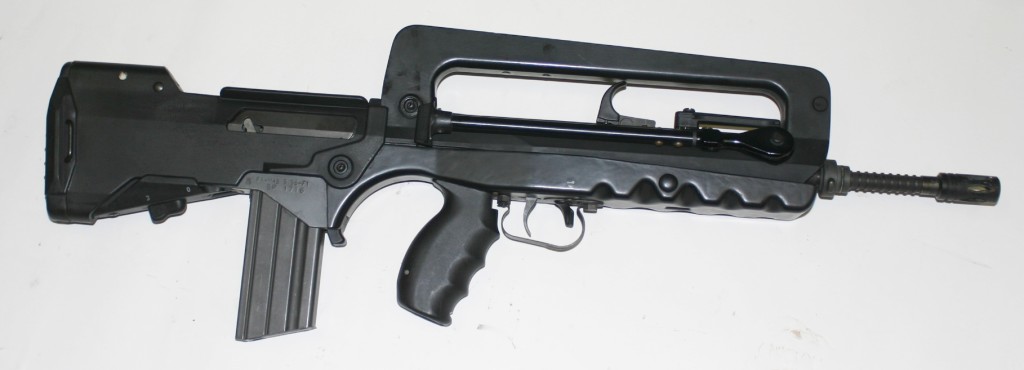
The FAMAS spent 9 years in development, beginning in the late 1960s and finally being adopted as the standard French Army service rifle in 1978 (replacing the MAT-49 SMG and the MAS 49/56 rifle). During this time, prototypes and 7 progressive variants were made (A1-A7) before finally settling on the F1 model for adoption.
Mechanically, the FAMAS works much like a San Cristobal carbine or AA-52 machine gun, using the lever-delayed blowback system developed originally by Pál Király. The bolt is not rigidly locked when fired, and immediately begins to move backwards. An “H” shaped accelerator lever is connected in the center to the bolt itself, with the bottom legs firmly against recesses in the receiver below, and the upper legs pushing on the bolt carrier. The accelerator cannot move back past the receiver lugs until it has rotated about 45 degrees, and its upper legs are longer than the lower ones. This forces the bolt carrier to move backwards much farther and fasted then the bolt itself can move. The time required for the bolt carrier to move far enough to release the accelerator lever and allow the bolt to move backwards is long enough to allow pressure to drop to a safe level in the chamber, and the built up momentum of the bolt carrier is used to cycle the action and load a new cartridge. A fluted chamber is used to facilitate extraction.
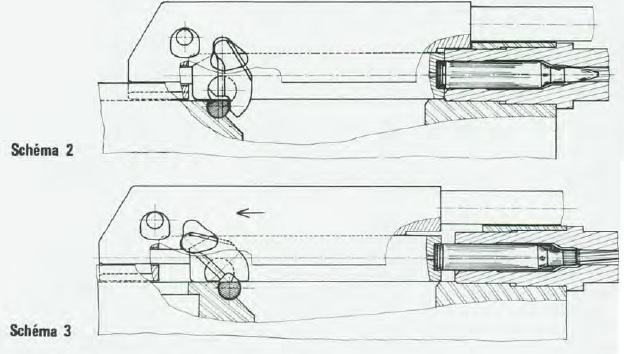
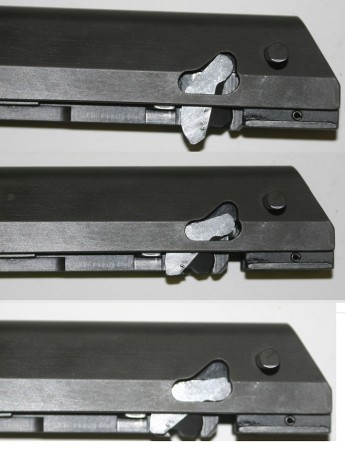
This system is fairly simple and negates the need for a gas system, but it does have limitations. It is really at the limits of a safe mechanism for a high-pressure cartridge like the 5.56x45mm, and does not have much tolerance for variation in chamber and barrel pressure. The initial F1 variant of the rifle adopted by the French Army was designed around the 55gr M193 cartridge, including a 1:12″ twist that is not compatible with the now-popular heavier 62gr and 77gr bullets. We have also been told (although not found confirmation) that the locking system itself is not overly reliable with heavy bullets, due to the difference pressure curve created by those rounds. The newer G2 and export versions of the rifle are built to run fine with heavier rounds (mainly SS109 62 grain), but the vast majority of Army rifles in use are still original F1 versions, which will eventually be replaced with a completely different rifle (the H&K 416, we understand) rather than reworking them for the new standards.
In addition, France had removed its military forces from the NATO union in the late 1960s, and the FAMAS was not designed around NATO standards, although it did use the same ammunition. Magazines were straight 25-rounders, not interchangeable with STANAG M16 mags (although this was also changed in the 1990s G2 version).
Unlike many other bullpup rifles, the FAMAS was not built with optics mounting in mind – it is equipped with iron sights inside the top of its carry handle. These are enough to get the job done, but not particularly outstanding. It is worth noting, though, that both the front and rear sights are actually mounted to the barrel and receiver, and the carry handle mounts around them. This does improve accuracy, as slop in the carry handle mounting will not translate into movement of the sights.
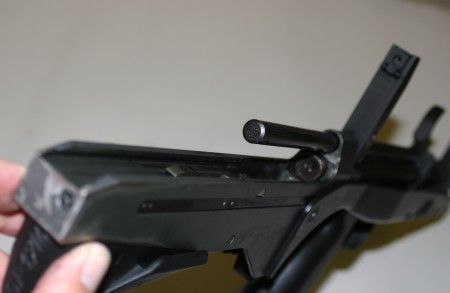
The fire selection leaves something be desired. The rifle has a safety lever inside the trigger guard, which rotated from left to right. The right (marked “1”) is for semiauto fire, the middle position (which physically blocks access to the trigger) is for safe, and the left (marked “R” for “refale”, or burst) is for automatic fire. That automatic fire can be either full-auto or a 3-round burst, as dictated by a second selector located under the buttstock. That one has markings of “0” (for unlimited full auto) and “3” for 3-round burst. Today burst firing has pretty much been determined to be undesirable, but it was still though to be a neat idea when the FAMAS was being designed.
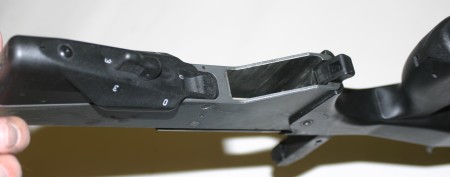
Most notable for an early-adoption bullpup, the FAMAS can be fairly easily changed from left-handed to right-handed use. The charging handle is entirely ambidextrous, located atop the receiver inside the carry handle. The bolt is made with cutouts for the extractor to mount on either the left or right side, and the receiver has ejection posts in both sides. The desired ejection port is left open and a detachable cheekpiece is mounted over the other one, and the extractor is fitted to the ejection side of the bolt. To switch the rifle’s ejection side, the extractor and cheekpiece are simply moved to the opposite sides. This is not practical to do in combat, so the rifle can’t effectively be juggled from shoulder to shoulder, but it does allow lefty shooters to use the rifle without handicap (and without needing to have any lefty-specific guns or parts).
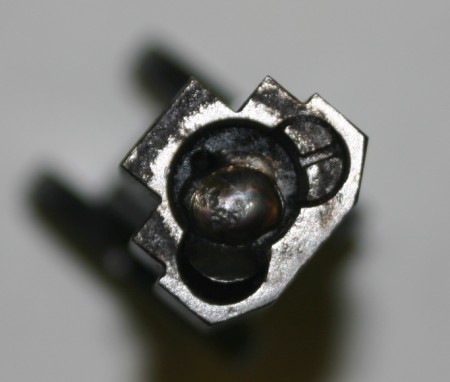
One other feature to note – the lever in front of the charging handle is actually a grenade launching sight. The FAMAS was designed to use 22mm rifle grenades that slip over the barrel. To aim them, the rifle is laid on its side, and that lever is flipped out to a detent setting based on the desired range of the grenade. The firer then sights down along that lever at the intended target.
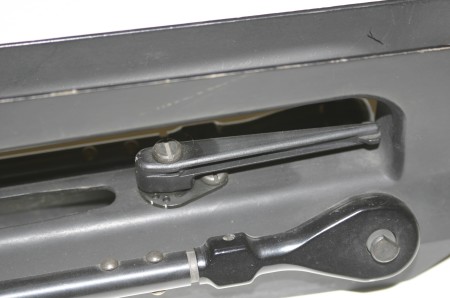
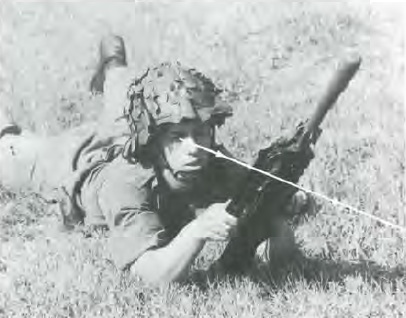
We have two manuals available for the FAMAS, one in French and one in English (both describing the original F1 variant):
FAMAS F1 manual (English)
FAMAS F1 manual (French)
You can also see the full gallery of photos (or download the whole batch here as a zip archive):
[nggallery id=180]

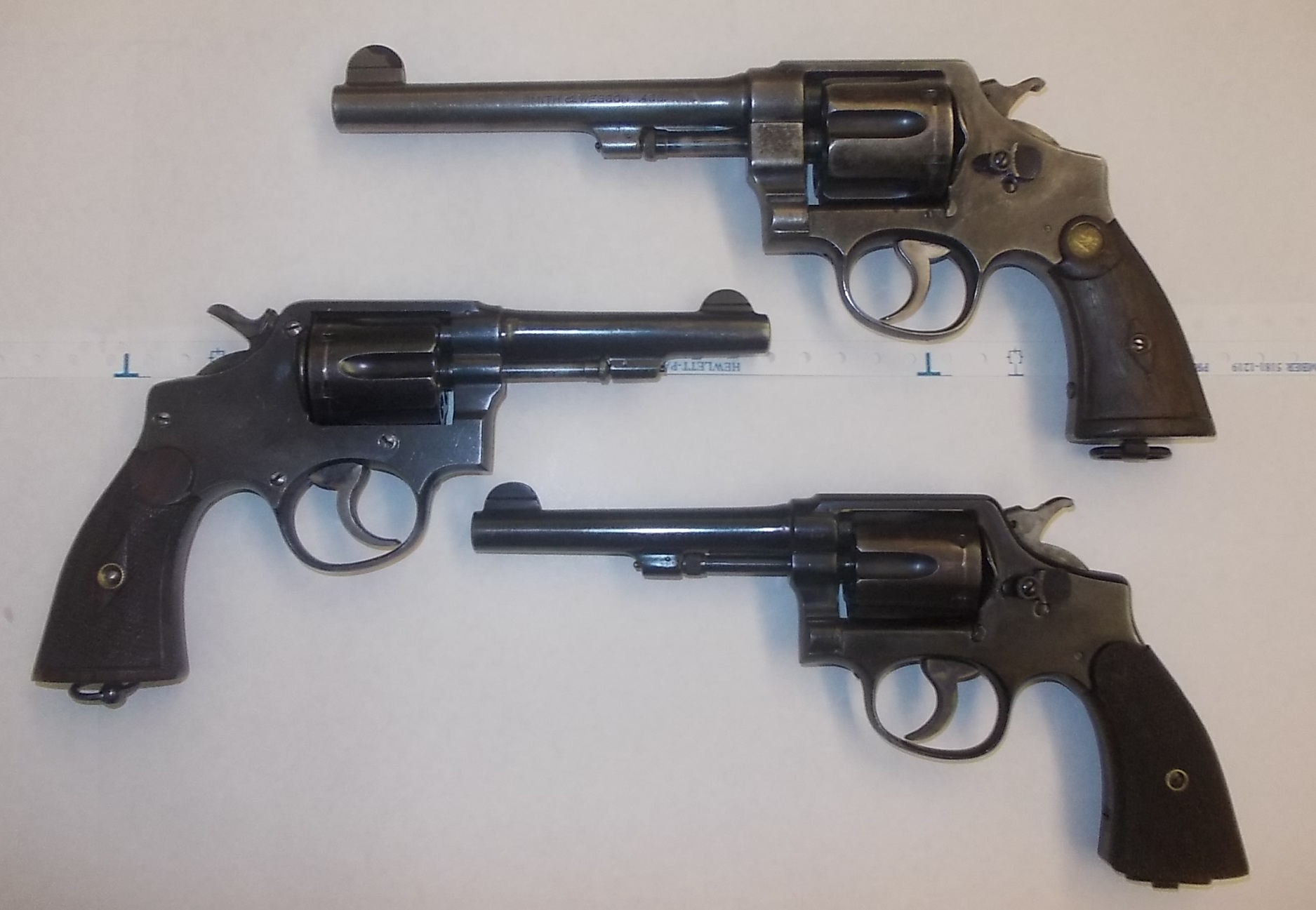

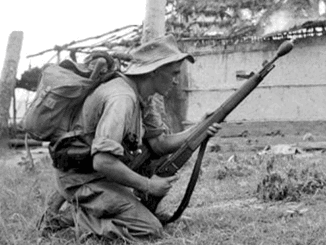
an animation to explain how the bolt works would be nice, because i am to simple (or more ” visually oriented”) to really grasp the working of the mechanism. why is the burst out of favor? the m16a2 or a3 (?) only has this option instead of full auto. i thought it was a way to fire a controllable and accurate amount of bullets.
http://firearmshistory.blogspot.com/2010/08/actions-blowback-action-lever-delayed.html
Try that, Eric.
I have a fascination with both the Kiraly lock and French stuff, so this is a real jackpot. Thanks, Ian!
The sight radius must be very short.
That just looks like a French designed rifle. Kind of bulky looking with weird bulges. As if different parts were pulled from a box and stuck together.
The FAMAS F1 was a poor replacement for the MAS 49/56. The new rifle was supposed to be a universal weapon that was accurate and reliable. The first thing noted was the 25 rd magazine was unreliable in spite of the fantastic money spent on its development. France is fascinated with rifle grenades. The NATO grenades for out 7.5 rifles were dangerous but few will admit it.The only ones that are safe to use are the smoke or illumination. The FAMAS F1 was accurate; quite accurate in burst fire. It to me they felt good on the shoulder and were easy to qualify with; but the honeymoon ended badly. Soon parts were breaking; the 5.56 round was not up to expectations and the bipod could be quirky. From prone the FAMAS is excellent. Soon however the burst fire device was despised. Then the magazines were failing. Rifle grenade practice would destroy good rifles.You illustrate indirect fire for the rifle grenade.There is a direct fire method for “anti-char” anti tank grenades. The sight for this is a spindly fragile thing and the grenades were wildly inaccurate. Soon we longed for the MAS 49/56 and the US M1 carbine. Later models of the FAMAS have addressed most of the issues.Rifle grenades will still destroy a rifle.The FAMAS is now made in a bewildering variety and is a popular and trusted weapon.Like our M16/M4 system. One last thing the FAMAS used the MAS49/56 bayonet; a knife that is not designed for the human hand.There are two muzzle rings so you have to hold it like an ice pick. To use it like a regular knife is difficult unless you have small hands.Hope this gives you some insights. Today the FAMAS is the equal of any 5.56 cal military rifle.
Hello, Andrew :
It was very interesting to read about your practical field experiences with the FAMAS. There seems to be a rough parallel between the early developmental problems of the FAMAS and the M-16, both of which finally evolved into reliable military firearms.
Could you elaborate on the details of how rifle grenade practice would destroy or damage the rifle?
Rifle grenades put undue stress on any rifle not designed specifically to fire them. The most accurate rifles be they Mas 49/56 or FAMAS were never used to fire rifle grenades. France issued a rifle specifically intended to launch grenades it was the MAS 1936/51. As to the FAMAS it could easily handle illumination or smoke grenades as they are of less weight.The anti personnel or anti tank grenades are heavier. The propellant cartridge is dirty and fouls the FAMAS.(not so much with the 49/56) Every time one fires a rifle grenade if indirect fire(stock on the ground) it will set up stress that will make the action parts loose.If one fires the Anti tank grenades it recoils harshly and is not accurate. As was posted they do have a different smell due to explosive composition. I doubt any accurate rifle could stand more than a few rifle grenades without ruining the accuracy. The FAMAS suffers from ammunition problems as well. The French first used SIG rifles in 556;ammo did not matter. The FAMAS first model would not reliably fire more than 600 rounds without gumming up. I do not remember if the ammo was contract or French made; but it was a 55gr US type of load. The powder burned dirty and did not always burn,leaving a residue that was sticky. While the M16/M4 had a long evolution to its current reliable form. The FAMAS is in evolution still. French engineering is often forward thinking but suffers in execution. As for rifle grenades; all rifles suffer from launching them.
Thanks for the update, Andrew — it is much appreciated. On the side, the dirty 55-grain M193 -type load you mention almost reminds me of the early CIS loads as well as Dynamit Nobel loads. They would fire reliably but leave a lot of dark, sticky residue in the chamber and barrel bore of any M16 rifle or M4 carbine using direct gas impingement operation. Frequent, thorough cleaning was required to address this problem, otherwise it would result in an increasing FTF and FTE ratio over a relatively short period of time.
French practice rifle grenades smell like shit, but do not “destroy” rifle.
I’ve never fired a 30mm grenade launcher, but those rifle grenades are pretty accurate ( about 5m ø circle at 300m).
The problem with the FAMAS is fouling. You’re lucky if you succeed to fire 500rds without stoppage.
I’ve never seen this problem with another lever delayed blowback rifle, therefore I think this is ammo related.
One thing that is hide in the stock, is a pretty ingenious recoil buffer. The bolt carrier at the end of its travel, hits a lever which in return compresses a spring. This system allow the recoil buffer to be before the end of the receiver.
http://ekladata.com/tanuki.eklablog.com/mod_article1289519_5.jpg?2211
http://images-00.delcampe-static.net/img_large/auction/000/151/085/599_002.jpg?v=5
http://images-02.delcampe-static.net/img_large/auction/000/151/085/599_001.jpg?v=5
The manual mentions the barrel life as being the following:
Barrel resistance: 10,000 shots, 420 grenades.
So, evidently grenades would cause problems with the barrel. 420 grenades is a lot of grenades, but I guess the point is that even normal training use would severely shorten the life of a rifle.
I’m just surprised though that rifle grenades would work at all with a delayed blow-back mechanism. At least with something like an FN-FAL you would cut off the gas. With the FAMAS, the system would have to cycle with much higher than normal pressure during the blow-back stage.
In WWI, soldiers would when possible use a “special” rifle for firing rifle grenades rather than use their own normal rifle. The special one would have the stock reinforced with wire, and the barrel would be one that had already been shot out or otherwise damaged. Those were rod type grenades, but even cup or modern style rifle grenades cause a lot of stress on a rifle.
The way that many modern rifles are built, I wouldn’t be surprised if they were nackered in short order by rifle grenades.
Well for example on how to do it right, the Zastava M70 series AKs not only have the gas cutoff, but the receivers are essentially RPK receivers – much thicker than an AKM – in order to make it that they don’t crack under the force.
Not only Yugos did it right – Polish wz.60 and wz.60/72 rifle-grenade launchers were built on AK (milled) action and fitted with a gas cut-off valve. Anyone willing to see these? I can cobble up an article with some photos about it.
Thank you for another splendid presentation.
Not entirely a terrible design. Wasn’t this gun supposed to use disposable magazines?
Plus, the fact that it used lighter bullets is what you want from small caliber high velocity ammunition-light, fast rounds.
Somewhat ugly, and I personally prefer the G2, but the straight magazine is funky, and on the whole, a pretty revolutionary design.
leave it to France to come up with something really different, given they are a pretty potent military power and do have a pretty good military history.
@Jeremy Barnum
Though there was indeed not small engineering modifications in providing Crvena Zastava types of AKM to fire rifle grenades (as you said gas cutoff, reinforcing receiver etc.),
unfortunately as A.Marcell said it good; “Rifle grenades put undue stress on any rifle not designed specifically to fire them”.
So it was with M70 series of rifle, and as a rule, you don’t fire rifle grenades from it if you want your rifle to be accurate, because from even a dozen fired grenades accuracy rapidly drops. These lessons were learned in practice very fast in the war in former Yugoslavia that ravaged in the 1990s, especially in 1991. when due to the chaos of the beginning of war, many brave new “soldiers” due to their overall inexperience of proper arms usage, “mistreated” their weapons. From that time there is also notorious opinion on romanian AKs, that were widely labeled “worst ever”, because often their barrels ended up destroyed as the users fired long bursts on auto through them. Also there were accounts of these same rifles, after the user spends the night patrol on the outside, in damp forest air, they ended up fully brown and rusted on the outside surfaces in the morning, suprising and frustrating the soldier…)
But that is another story that needs to be properly qualified and researched, because to this day, there are is no consensus on why rom. AK barrels overheated that much on auto fire, to the point that they bended (because on semi auto fire rifle was acting OK, but neverthless users threw away that rifles as soon as they could get their hands on yugo AK) As I said in one other reply on some other thread, on the other hand, yugo SKS, the PAP (PoluAutomatska Puška = SemiAuto Rifle) was excellent at firing rifle grenades.
Pal de Kiraly’s san Cristobal Carbine patent http://worldwide.espacenet.com/searchResults?compact=false&PN=US2741951A&ST=advanced&locale=en_EP&DB=EPODOC.
Lever delay seems like such a simple concept, but what complicated swine the geometries of those accelerator arms and their bearing surfaces inside the receiver and the bolt carrier must be to generate!
I’m guessing that they are manufactured as long strips, then mounted in a lathe and a parting tool used to form the spindle in the middle and part the individual accellerators off.
__________________________
There was an article a decade or two ago (I’ll see if I can find the ref) about a gentleman who had developed a single roller version of a Pederson / Remmington style, delayed blowback pistol (pederson patent is US1348733A)with the single roller located behind the mag well.
Depending on the angles used, that is a simpler to manufacture functional equivalent of the de Kiraly system.
Any auto design is going to have difficulties when it encounters different bullet weights and different pressure/time characteristics.
While the angles on say a cetme type roller lock are easier to alter than the geometry of an accelerator, there shouldn’t be too much difficulty in adding a few ounces to the bolt carrier to delay opening with the later, heavier bullet loads, and adding some Belleville washers to the buffer, to dampen the greater momentum.
_________________________________
I can never understand French gun makers love affair with roll pins. My one and only French made gun is also held together with them, and the originals were crumbling when it came to me. The one thing in their favour, was the replacements were easy to source.
Edgar Budischowski’s Korriphila?
http://world.guns.ru/handguns/hg/de/korriphila-e.html
Sorry, I didn’t see your link before I commented with the patent link. That’s the one I found,
I was looking for a similar one which was written up in (iirc) gun digest about 20 years or so ago. I seem to remember it was a man in the US and he was working on .45ACP.
My old gun digests are still at my ex’s place – they’re a pretty low priority 😉
Found one roller lock, but not the one I was looking for, which I think was in an old Gun Digest (my copy’s in another country)
http://worldwide.espacenet.com/publicationDetails/originalDocument?CC=DE&NR=2822914A1&KC=A1&FT=D&ND=3&date=19791129&DB=EPODOC&locale=en_EP
I also found reference to Chiappa producing a gas delayed 45ACP, which I’ll link to in the Steyr GB comments.
Lever delayed blowback
http://www.m1911.org/hogueavenger.htm
Thanks Fidel
The schematics at the link looked a bit like patent diagrams, and sure enough:
http://worldwide.espacenet.com/publicationDetails/originalDocument?CC=US&NR=2007012170A1&KC=A1&FT=D&ND=3&date=20070118&DB=EPODOC&locale=en_EP
It’ll be a few days before I get that one read and thought about. 🙂
http://www.getgrip.com/PDF%
20files/Avenger%20Manual%
2009.pdf
I’ve found one of the guns I was thinking about – but it isn’t roller delay, it uses a breech bolt with angled camming surfaces within the slide, and is broadly simillar to the Pederson and Bernardelli designs.
It was by Ross Rudd (the only patent I can find by him is for an M1 Carbine trigger mechanism) and was featured in Gun Digest Annual 1994, pp 156 – 160. The Pistol was .45 ACP, there was also a .223 rifle shown operating on the same principal, using what looks like an AR180 lower
according to a note, Rudd died before the article was published.
I still vaguely remember seeing a picture of roller delay pistol, which I’m guessing now was perhaps, Budischowski’s Korriphila
The Kiraly lever ‘lock’ probably requires a fairly sophisticated heat treatment and a lot of alloy steel in the firearm to be safe and durable. This impedes mass production in a ‘war emergency’ situation (or an impending gun ban situation!).
Why is burst fire discredited? I thought burst fire was the basis of the German EMG developments in the 1930’s.
I wouldn’t say that burst fire was “discredited”, but rather that users decided it required a lot of expensive, fragile, and failure prone mechanism for little benefit.
Burst mechanisms were specified on the theory that national service conscripts with minimal training would waste ammunition and damage their rifles by firing long bursts on full automatic. However, experience showed that burst mechanisms were unreliable. After the end of the cold war, many major armies changed from being primarily mass conscript armies to volunteer professionals, so the “limited training” issue disappeared.
I can’t recall particular models, but I do recall reading that some rifles with burst mechanisms tried to deal with the reliability issue by making sure that repetition and full automatic modes shared no common components with burst mode. Others made it possible to easily remove the burst mechanism if it failed, without affecting the other modes. In other words, the manufacturers gave up on trying to design a reliable mechanism and simply made it easy to ignore the presence of a mode which was only there to satisfy a Defence Ministry specification.
To add to MG
France has only abandoned mandatory military service in the past 15 years or so. The rifle will therefore have been specified for teenage conscripts.
The counter mechanisms for short bursts are little toothed ratchet affairs, more akin to a clock escapement than they are to the simple hammer, sear, disconnecter and auto sear of a conventional selective fire lock.
The burst fire also raises questions about the attitude of the notoriously mendacious French bureaucracy towards its young (enslaved) citizens.
If they’re in a situation where they fire a long burst, chances are they actually needed to. Are their lives actually worth less than a few rounds of 5.56?
Excuse me, but what EMG (Einheitsmaschinengewehr, or GPMG) development in the 1930s has to do with today’s individual rifle and the way it is tactically employed? Machine gun is a team weapon, a source of fire support in a fire fight, and it is just natural, that machine guns are fully automatic-only weapons – and mostly fire from an open bolt, last Mohicans like .50 BMG and dead-ends like L86A1 LSW or Colt LMG excluded. Automatic rifles, on the other hand, are individual weapons, designed for aimed, accurate semi-automatic fire from a closed-bolt position, with an OPTION of emergency full-auto in CQB scenarios. Option, meaning they are NOT designed to be fired in fully automatic mode for prolonged periods. Fully automatic fire has nothing to do with accuracy, it gives a pure firepower though, pumping lead by the pound SOMEWHERE around the enemy, to make him duck or to hit him eventually, after saturating landscape with enough lead. Burst, especially the controlled-length burst, has the worst of two worlds. It is neither precise enough to hit the target, nor long enough to bury him under leaden hail. It could have been another story with SPIW- or G11-category weapons, able to fire these 3 bullets at ROF counted in the thousands of RPM, letting several bullets fly before the rifle transfers the recoil to the shooter. At 1800 RPM with a 3-rd burst you hit the target three times before he knows what hit him. At 600 RPM 3-rd burst is a waste of ammunition – perhaps the first bullet hits the target, but why waisting the other two? And add that the M16A2 burst controller is perhaps the worst ever designed, devoid of self-zeroing ability, if you stop a burst prematurely. French, or the other controllers, even if useless, at least work the same every time you pull the trigger. On a FA MAS F1, with ROF zinging 1000 milestone, it is very difficult to master the trigger enough to squeeze short burst – and that’s why they put the controller, to aid conscript soldiers in training. At least you don’t have to use the controller – you can disable it with the rear selector and forget about it – after all you are not a machinegunner and you don’t HAVE to fire bursts, long or short.
Now, getting back to the Great Rifle Grenade Controversy, in the Polish Army the curious love of rifle grenades made even the Mini-Beryl carbine (235 mm bbl) to be rifle grenade capable. With the older 7.62 mm weapon, the wz.60 grenade launcher was issued at a one per squad ratio, being a specialist weapon, but now all Beryl rifles are capable to launch bullet trap grenades with no special preparations at all. Our army has got long experience with rifle grenades. And tell you what – rifle grenade launching is never healthy for a rifle, good or bad. First, it generates much higher stress level compared to shooting bullets. For this reason alone, you should refrain from shooting grenades if you still want to shoot your rifle true. In Beryl rifles it stresses the rivets, making the receiver cheesy, the stock hinge doesn’t like it, develops a rising degree of play (which is always a bad thing for accuracy), plastic magazines are known to crack under the stress of firing grenades, red point sights getting jarred on the top rail enough to loose zero or damage the rail (EOTech 552 is big and heavy enough to make much damage). Many bad things are going on, as the rifle grenade work is NOT what the rifle has been designed for. In the world of mortars light enough to become individual weapons (like Czech ANTOS 60 mm) and disposable AT launchers in general use, rifle grenade is a growingly obsolete contraption – but in a pinch, one would cling to a razor for floatation, as the Polish proverb goes.
Sir, I believe that you are refering to my comment that the FAMAS was intended to be a ‘universal weapon’. My I clairify my position; in the 1970s the French were using thrs MAT 38 and MAT 49 SMGs; the MAS 36;36/51 bolt actions in 7.5mm also the MAS 1949 & 1949/56 semi auto rifles along with M1 carbines and SIG 556 cal rifle. Also there were M16 and XM 177E2s (sililar to M4 carbines) and mini 14s. This was a logistical and training nightmare.In some arms lockers there were Berthier carbines for launching tear gas grenades. Well,it be came clear that a universal weapon in the NATO caliber would be superior to what was in service. The weapon chosen was the FAMAS short enough to be a submachinegun, powerful enough to be deadly out to 400 meters. Large enough to be a bayonet handle. Like the US issuing the M4 to everyone the FAMAS was intended to be an effective weapon for anyone in need of one.
As for Rifle Grenades; it seems any country that was victim of the blitz wants many layers of anti tank defenses.Rifle grenades may be effective at close range but as you say accuracy is ruined. The US LAW is a good solution and many other countries have developed similar weapons.
I have seen almost every Com Block AK variant given as aid for the brush wars. Polish weapons were almost never seen. How do they stand against their contemporaries as to accuracy and durability. If the Polish P64 pistol is an example Polish weapons must be excellect.
Please forgive my English as it is my second language.I hope this makes clear what I wa saying
* Capacity of launche the Rifle Grenade is mandaotry specfication of gerneral pupose assault rifle for French army. The hight price of the FAMAS could be explain in the reinforce structure for that stuff.
* The French army use Rifle grenade till the weigh of 500G. Why Rifle grenade, because each members of a platoon could have 1 or 2 Rifle grenade with him and you have not the problem when the wearer of the grenadre laucher is shootdown (by adverse sniper /DRM) .. any guy in good position could lauch an rifle grenade ..
* In plus, The FAMAS F1 wase build with geurilla & long trench warfare in minde : the stock of the Rifle is not polymer but in Fiberglass (and could be repaire in Car repair Shop) …. Limitation of the need of raw materale like iron, aluminium is at the minimu…,
In Plus, the bullpud configuration was because french infantrie men are in amors cars (VAB) since around 1960’s.
And Why gurilla in mind, rember you at this time (1970’s) in case of invasion red armies, the deafate of West germany in few week could be possible, and the flee of Brits (like durring the batle of Dunkirk in 1940) … the French Force could be stay alone againt Warsaw Pact
Edgar Budischowski’s Korriphila?
http://world.guns.ru/handguns/hg/de/korriphila-e.html
I do have a quibble on “direct” vs. “indirect” fire. High angle fire where the shooter can see the target, at least in US Army verbiage, remains direct fire. (With mortars, the weapon it is most often done with, the crew drills are often called “direct lay” because you lay the mortar directly against the target, rather than against an aiming stake).
“Indirect fire” is fire where the gunner do not have line of sight on the target, for example mortar or artillery positioned behind a hill.
Re:rifle grenades. They were integraed in US tactics in WWII. WWII US practice had a big influence on the Free French Army.The US went to the 40mm GL but you didn’t see any European army joining in, they stayed with rifle grenades for AP and AT use. Most of them developed dedicated AT weapons (Panxerfaust 3, Armbrust, Blindicide, Carl Gustaf 82mm) because a rifle grenade has a hard time packing a powerful enough charge to have a serious argument with a main battle tank. All you’re going to do is make him mad at you.
And then he’s going to want to fight…
Remember that France led the world in tank-killing ATGMs, so they kind of leapfrogged our crew-served AT weapons. The Russian Sagger is a knock off of French SA-11 technology, and even the US adopted SA-10 and -11 in small numbers. Obsolete as halberds now, but state of the art fifty years ago. ISTR that France was in the consortium that developed the MILAN as well.
I find French weapons to be somewhat hit or miss. M49/56 was a really good gun with some French quirks, kind of a Citroën DS of a gun. AAT 52 was a dreadful gun with some French quirks, more like a Renault Dauphine….
I think you meant to say Carl Gustav 84mm ( recoilless rifle ).
It’s also interesting that you brought up the Brandt-ENERGA RL83 Blindicide and MBB Armbrust, both very good man-portable anti-tank weapons in their own right that are not well-known in the United States.
The French were using rifle grenades in WW1 the best was the VB that looked like a funnel;the grenade had a hole in the middle.A ball cartridge passed through and triggered the fuse and propelled the grenade.This was the best launcher of its time and was used by US troops in WW1. The grenades were lobbed in an arch.IE indirect fire. The difference between indirect and direct fire is that direct fire is aimed using the grenade body and a rear sight on the weapon and the weapon is held in the least painful way.Direct fire is used for anti tank grenades;or anti material grenades. Indirect fire is used with the rifle’s butt on the ground and a separate sight usually for one fixed angle is used. Grenades for indirect fire are ranged by their position on the barrel.Grenades so fired are usually anti personnel smoke,WP or signaling.
You are correct about the AAT52. It is a dreadful weapon. France has some very advanced anti tank weapons. They remember the German use of tanks and like the idea that every infantryman could fight a tank. Unfortunately the AntiChar grenades are painful to shoot and cause flinching.In theory they are accurate to many hundred meters.Maybe it is fair to say a big soldier with skill could hit a tank at 150 meters.. Hope this helps.
The Russian Sagger is a knock off of French SA-11 technology, and even the US adopted SA-10 and -11 in small numbers…
You mean SS.10 and SS.11?
I’ve always been mystified by the fact that France insisted on designing their own, lower-capacity magazines instead of copying the perfectly functional 30-rounders that the rest of NATO was using. It’s not as if their 25-rounder offered any improvements.
That said, I’m not sure a rifle that’s still standard-issue for the world’s 14th largest military can be called a “forgotten weapon”.
The first magazines were intended to be disposable. This was soon seen to be wasteful and the disposable ones could be reloaded and sometimes worked. They were shorter because of three reasons. 1- They were French;2- the M16 magazines were thought to interfere with prone position firing; 3- Few 30 round magazines actually work when loaded to their 30 capacity.The FAMAS 25 rd magazines were reliable with a full load when they were new. NATO imposed the 556 round on its members. France always marched to their own drummer but saw that 556 was the way to go; yet they will scream if you suggest it had anything to do with NATO. Most feel the 7.5 was an excellent combat round; but there was no new platform for it, so the 556 round was chosen. BTW Steyr’s AUG was the first bullpup fielded in 1978.
So basically, they were originally thinking that the FAMAS mags would be like the modern version of stripper clips, use once and throw away? Wow. The French have had some great ideas with firearms (they invented smokeless powder, after all, and were the first to make a serious effort at a general-issue semi-auto rifle), but they’ve had some awful ones too.
Some interesting stuff in the discussion here.
I’ve been in the French army for a couple of years as some sort of “conscript level” voluntary soldier, and used the Famas in training. I never used it on the field but learned quite a few interesting things.
First off, the Famas is a bullpup, as you all know. This brings many interesting features, for relatively few disadvantages, all things considered. Bullpup design of the Famas allows people with a solid back, but not strong arms, to wave the gun around and keep “aimed” position for a long time: The FAMAS (F1 on which I trained) in rather heavy, but you don’t feel that weight in your arms at all: All the weight being on the rear/stock, which makes you carry the rifle with your back/shoulder. The arms barely carry anything. It is easy to wave it around and aim quickly without much if any momentum, allowing a very fast aim. It doesn’t tire you at all. It is easy to use in upright position.
The short bullpup design also allows for easy transportation in transports: Trucks or APCs that the French army loves. Some say the bullpup design prevents good reload speed: This is not true in most situations, it’s only a question of habit.In fact, it’s pretty easy to reload the gun even in confined spaces. However, depending on the hand you use, you can lose track of your target while reloading. Also, reloading while being prone is kind of a chore due to your body being in the way. Speaking of the magazines: Yes, the 25 round magazines were originally intended to be throwaway mags, which explains why they’re so poor. The lips are very fragile which requires a lot of caution otherwise they get bent and you get a lot of misfires. I think a lot of the bad rep’ the gun gets in terms of reliability is due to the improper use of the magazine, due to the magazine being designed around a bad concept. It is interesting to note that the Famas was designed as a really sturdy rifle to hold for 2 or 3 decades while their magazines were designed to be throwaway. Typical French design absurdity.
The “burst fire” issue; Burst fire has been advertised to us as something pretty useless: The first two rounds gets on target, but the third one always goes haywire. However, burst fire isn’t a stupid idea in itself for a conscript army. A clear example is a very recent and tragic example: http://en.wikipedia.org/wiki/Uzbin_Valley_ambush . This ambush went tragic for several reasons, but one of them was a relatively light amount of ammunition combined with many “green” soldiers involved in the clash. This led to ammunition being spent absurdly fast. In my opinion, burst should only be a “double shot” on a rifle with high RPM and 5.56 ammunition: Our instructors always told us to fire twice in quick succession anyway to be sure to do damage. Full automatic however is pretty useful… But here, the very high RPM ends up wasting a lot of ammunition due to the difficulty to control it. The Russian AN-94 is potentially the best rifle in terms of burst/RPM: It can fire a double shot at 1800RPM, but when it “full auto” the RoF drops to 600/m allowing a lot of control over the rifle. Of course, that costs a lot, and is complex to manufacture, but it’s the best of all worlds.
Speaking of ammunition, the original French rounds had steel casing (instead of NATO copper) and the barrel had non NATO rifling adapted to the rounds. The steel casing allowed for better propelling and less stress on the chamber, and the rifling was adapted to that round. When the steel cased rounds stopped being produced, the French had to get the NATO standard rounds, which causes several issues: The barrel rifling is wrong (on the F1), meaning the bullet starts wobbling past 50m, and the chamber wasn’t suited for the copper cartridge, causing misfires. G2 and later models are suited for NATO standard, but F1 aren’t. At least 5 years ago, a friend had told me they were still using the old steel ones in A-stan on their rusty F1 (depends on the regiment. Some have later models).
Rifle grenades: I never had the opportunity to use them. However, you have to remember several things: The FAMAS is a bullpup, so underbarrel launcher ruins most of the advantages of the design, and the early system was very clunky. In fact, in the old days, you had to load blanks to fire the grenades. They since improved it so that the grenades would be set by a bullet trap, so it isn’t as bad. You can’t mount the bayonets and still fire the grenades though. All has been said for the pros and cons before me however.
Disassembling the rifle is pretty easy, with all the pins. Reassembling it however is a real #hem# beach #hem#. As the article points out, switching from left to right handed can’t be done on the field properly. What it doesn’t say however is that you basically have to hold 3 pieces together (the infamous “mickey mouse’s ears”), two of which are very tiny and hold on the central one only through notches, + a spring in one hand, while the other hand brings the receptacle (bolt-face picture). Once this is assembled, you must keep your thumb on to prevent the pieces from jumping off while you place it in the gun. And if you put the wrong “ear” on the wrong side, you’ll be left with a right/left handed gun that you need to reassemble again. A real chore.
The bipod is a “false good idea”. They break off easily, take rust, and can’t really be set properly (pre-set length). The stock can’t be tweaked either for better ergonomy. The [whatever you pull to arm the rifle] is really dangerous since it moves while firing, so you must never ever put your hand in what looks like a handle on top otherwise you lose fingers. The sights suck.
Overall though it felt allright. I think, when it was new, it was one of the best rifles around, with quirks to be fixed. It was designed around a specific type of warfare based around mobility/harrassment (reatreat-counter-attacks) that was exactly suited for the French cold war doctrine.
However, nowadays, between the wear of most of the rifles, the lack of light arms industry to properly improve the design, and some original design flaws, it is far from being a must-have for Americans that may want to buy one. I truly believe that they could take a lot of the ideas of the FAMAS and design a whole new rifle around the core ideas for something pretty good.
What exactly are the differences between the famas mags and a regular AR mag? Could it be possible to convert an AR mag to run in a famas?/has anyone ever tried?
love your shows. Fyi 4.8 mil people traveled to Yellowstone park before November this year. a significant number through Cody WY with covid people are driving as apposed to flying As you stated the Cody Museum is world class Therefore, Cody is not in the middle of nowhere